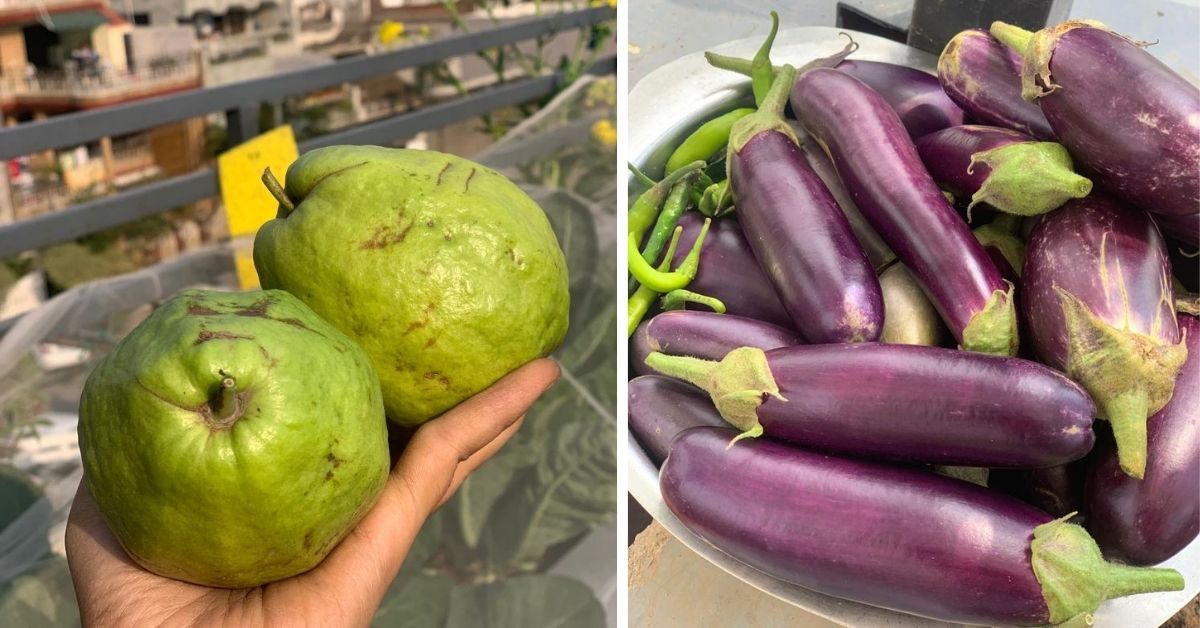200 Plants in 2000 Sqft: Gardener Grows all Veggies for the Household on Her Terrace
Ravneet Kaur based in Ludhiana began with the assumption that she did not have a green thumb. She now grows cauliflower, broccoli, cabbage, radish and more.

Ravneet Kaur’s terrace garden in her home in Ludhiana is a green oasis. With over 200 plants, she often spends her time amongst the greens.
“In 2019, for the very first time, I tried growing wheatgrass for my father who was unwell. Up until then, I did not think I had a green thumb,” says Ravneet to The Better India.
Subsequently, during the lockdown, she started to experiment with planting new varieties of vegetables and fruits. Seeing them all thrive motivated her to plant more.
“I grew up in Chandigarh where our backyard had numerous fruit trees. So in a sense, I grew up amidst greenery. I missed that when I married and moved to Ludhiana.” she says. However, with time on hand during the lockdown, Ravneet started growing things on her terrace.
Watching online videos of people growing plants on their terraces and small spaces was a huge motivation to her. “I draw a lot of inspiration from two avid gardeners – Garden Up by Ekta Chaudhry and Worm Rani’s videos. I started my journey with five pots,” she adds.
A Family That Gardens Together, Stays Together

In Ravneet’s home, she says that her in-laws also enjoy tending to their garden. “My in-laws grow all kinds of flowers. They are both interested in it. So, I decided to use the terrace space to grow vegetables and fruits. That adds to the mix,” she says. She started with growing spinach and brinjal. “I am glad I started with this considering that they are reasonably easy vegetables to grow,” she says.
“However,” she says, “It’s not all been easy. I remember planting the brinjal and a lemon plant and kept waiting for it to flower. Despite being easy plants to grow I got nothing from them. What it taught me was patience – the more the patience, the better the chances of growing your food.”
After the initial hiccups, she started with planting zucchini and bitter gourd (karela). On average, she says she spends close to two hours on her terrace tending to the plants. “In the winters, I prefer going up in the afternoons when the sun is nice and bright. While in the summers, I go up earlier during the day or sometimes even in the evenings.”
While Ravneet says that she has never taken stock of how many pots she has, she is sure that they will be upwards of 200 pots. “I also have huge flower beds that have been constructed all around the terrace, so those cannot be counted as pots but fit a lot of plants in them,” she says. The approximate space available to her is 2000 sqft.
A Plant Aficionado

Ravneet describes herself as a “plant aficionado” and has an Instagram following of over 70,000 followers. “I pursued my Bachelors in Commerce (B.Com) followed by a Masters in Business Administration (MBA) and then got a Bachelors in Education (B.Ed) degree. I had no connection to agriculture in any way but yet found so much happiness in what I do. The amount of peace I experience while working with plants is so gratifying,” she adds.
“I grow fruits and vegetables following the weather conditions. I have been growing cauliflower, broccoli, cabbage, radish and carrots during the winters. Now that summer is fast approaching, I am getting the pots ready for cucumber, bitter gourd (karela), lady’s finger (bhindi), pumpkin, squash, tomatoes and melons.”
The guava and lemon plant have been potted in a 20-inch plastic pot and Ravneet says that they are both thriving. On her Instagram page, Haryali_by_Cherie, Ravneet puts up videos on how to care for each crop.
View this post on Instagram
In your journey of growing your own food, she says that there will be instances where you fail. Either the weather conditions are not on your side or there is an outbreak of a pest attack. “The best way to deal with it is to keep going. Start with the assumption that you might fail,” she says.
From everything that she grows, she says the yellow watermelons are her favourite. “Even the tomatoes I grow are unique and referred to as an heirloom variety, which is resilient to the Indian climate. I found these seeds from another gardener on Instagram,” she says.
4 Tips For Novice Planters
1. Have patience:
Not everything will grow at the same pace. Allow it the time it needs and you will reap the benefits. “I was trying to grow lemon and guava, both of which refuse to fruit. With patience, I also invested time in reading up about these plants. That helped me nurture them better. Recently, both the plants gave me several fruits,” she says.
2. Go Desi:
“As much as possible, plant things that are indigenous to the place you live in,” says Ravneet. Look for desi seeds from your local nurseries and communities. You will find these plants growing better. Avoid buying seeds and saplings online or from people from different states. The soil conditions might not be conducive to growing what you have purchased.
3. Grow What You Eat:
“There is no point in growing fruits and vegetables that you do not consume. Ensure that you plant and nurture what your family and you can enjoy,” she says. Talking to the local mali (gardeners) or the nurseries will also help you in procuring the plants and saplings that you wish to grow.
4. Always Grow Seasonal:
“The best way to get your plants to flourish is by planting them according to the season. Do not plant the wrong things in the wrong season. There are specific winter and summer fruits and vegetables, so learn up before you start,” she adds.
View this post on Instagram
(Edited by Yoshita Rao)

Similar Story

‘I Took A Risk & Won’: Wheat Farmer Switched to Growing Lemons, Earns Rs 7 Lakhs Per Harvest
Observing the year-round demand for lemons, Anand Mishra switched from growing traditional crops like wheat, paddy, and peas to cultivating lemons in Uttar Pradesh. With his two-acre farm now yielding Rs 7 lakh in profits, he explains the reasoning behind this ‘unconventional’ change.
Read more >
If you found our stories insightful, informative, or even just enjoyable, we invite you to consider making a voluntary payment to support the work we do at The Better India. Your contribution helps us continue producing quality content that educates, inspires, and drives positive change.
Choose one of the payment options below for your contribution-
By paying for the stories you value, you directly contribute to sustaining our efforts focused on making a difference in the world. Together, let's ensure that impactful stories continue to be told and shared, enriching lives and communities alike.
Thank you for your support. Here are some frequently asked questions you might find helpful to know why you are contributing?


This story made me
-
97
-
121
-
89
-
167












